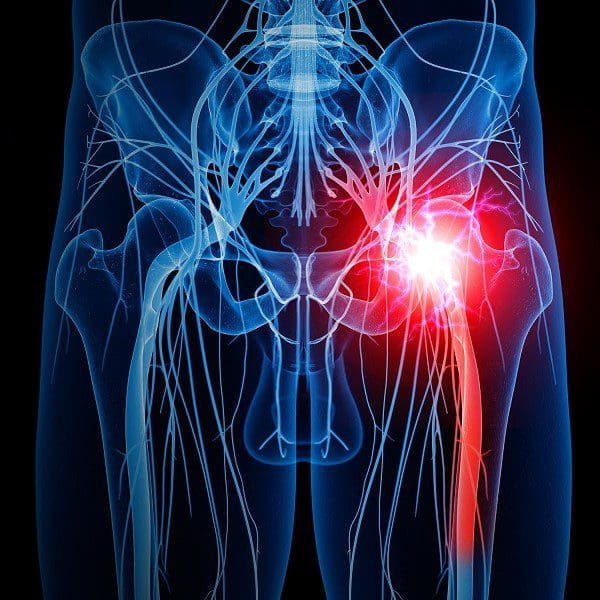
Overview
Sciatica is a specific type of pain that radiates down the sciatic nerve. Which extends from your lower back, into the glutes and down the back of the legs, however sciatica generally takes place down one side of your body. The main cause of this happening is when a herniated disk, which is bone spur on the spine, compresses part of the nerve. This can cause numbness and pain in the legs and also inflammation. Generally this is not considered as anything serious and in most cases will goes away after a few weeks. On rare occasions a patient may need surgery but this is only a result if there is a significant weakness in the legs.
Anatomy
The sciatic nerve is the biggest and longest nerve in the human body, starting at the base of the spine, into the gluteal region and running down the back of the leg into the toes. The sciatic nerve is formed in the lower spine by the combination of motor and sensory fibers from spinal nerves L4 to S3. These spinal nerves belong to a larger group of nerves in the lower spine called the lumbosacral plexus.This long, thick, nerve then divides into the Peroneal and Tibial nerves which innervate different parts of the lower leg, foot and toes.

Symptoms
Pain that forms and travels through your legs up via your glute and into your back is the biggest and most common sign that you may have sciatica. Discomfort can be felt almost anywhere but this is more apparent through the nerve pathway through the areas stated above. Feelings such as burning pain can be felt through sciatica and this may be mild or severe. This can sometimes feel worse or be more painful when you sneeze or cough, additionally sitting for a long period of time can also aggravate this more. Another main symptom is numbness or tingling, this is commonly known as the phrase pins and needles. Muscles can also tighten and become weak in the leg and foot.
Causes
Sciatica occurs when an overgrown bone is on your vertebrae/ herniated disk in your spine and results in the sciatic nerve getting pinched.
Some factors such as age can not prolong sciatica. There is sometimes nothing you can do to stop this. Obesity can also be a factor as this puts stress on your spine and the extra weight can cause spinal changes leading to sciatica. Your job can also play part as a factor, for example if you have a heavy lifting job or a job that requires you sitting down for long periods of times like driving long distances. Diabetes can also enhance sciatica because of the way your body uses blood sugar, and increases your risk of nerve damage. Finally not being active can also trigger sciatica.
Diagnosis
Sciatica is commonly diagnosed through the patients history taking and physical screening. By definition patients mentioning the radiating pain in the leg will spark the sciatica diagnosis. They may be asked to report the distribution of the pain and whether it radiates below the knee and drawings may be used to evaluate the distribution. Sciatica is characterised by radiating pain that follows a dermatomal pattern.Physical examination largely depends on neurological testing. The most applied investigation is the straight leg raising test.
Treatment
As stated before sciatica can go on its own so in most cases you won’t have to do an awful lot however some cases are worse than others and there are various things that you can do to help treat this. Easy things like making sure that you stretch regularly can help massively. This allows you to keep your muscles stretched out and start to stimulate the nervous system.
Massage can be really beneficial also and this also helps stretch the muscles and really stimulate the nervous system by increasing the blood flow especially in the legs.
Exercises
Glute Max Stretch
Piriformis Stretch
Hamstring Stretch
Quadricep Stretch
Trigger Point the Piriformis Muscle
Please see some exercises and stretch examples in our video.
Prevention
As Sciatic can be idiopathic it is not easy to prevent its occurrence. If possible avoid repetitive activities, when unavoidable take time to perform stretches and take regular breaks. Be aware of the first signs of symptoms developing, the earlier you start treatments the quicker it can be resolved.
The video above is not just to help rehabilitate the area it will also help in strengthening the area and again you should seek professional advice for this.



